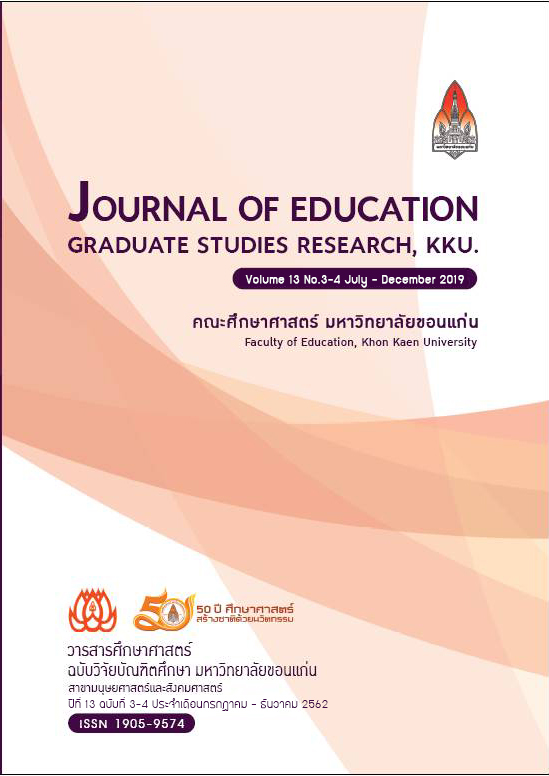The Development of English Reading Comprehension and Analytical Thinking Abilities of Grade 9 Students Using Murdoch Integrated Approach with Graphic Organizers Technique
Main Article Content
Abstract
The objectives of this research were to develop English reading comprehension ability of grade 9 students using Murdoch integrated approach with Graphic organizers technique so that they would have average score not less than 70% of total score, and there would be 70% up of the total number of the students passing criterion, to develop Analytical thinking ability of grade 9 students using Murdoch integrated approach with Graphic organizers technique so that they would have average score not less than 70% of total score, and there would be 70% up of the total number of the students passing criterion. The target group used in this research was 37 Grade 9 students of Kudbongphitthayakarn School under The Secondary Education of area office 21during the first semester of academic year 2018. The design of this research was the Action Research. The instruments used in this research categorized which were: 1) 7 Lesson Plans in English language using Murdoch Integrated Approach with Graphic organizer technique for 14 hours, with the average of 4.52 that is highest level. 2) Research reflection tools consisted of Teacher’s teaching behavior observation form, Students’ learning behavior observation form, Students’ opinion record, Students’ interviewing record, Instruction records, End-of-spiral English Reading Comprehension Ability tests, with the index of item objective congruence of 0.67-100, the difficulty degree of 0.26-0.66, the discrimination degree of 0.31-0.89, and the reliability of 0.82, 0.75, and 0.77, and End-of-spiral Analytical Thinking test, with the index of item objective congruence of 0.67-100, the difficulty degree of 0.31-0.63, the discrimination degree of 0.43-0.77, and the reliability of 0.79, 0.81, and 0.85, and 3) Assessment tools consisted of English Reading Comprehension Ability tests in 4 multiple choices for 30 items, with the index of item objective congruence of 0.67-100, the difficulty degree of 0.37-0.66, the discrimination degree of 0.37-0.65, and the reliability of 0.90, and Analytical Thinking Ability tests in 4 multiple choices for 30 items, with the index of item objective congruence of 0.67-100, the difficulty degree of 0.31-0.63, the discrimination degree of 0.43-0.77, and the reliability of 0.79, 0.81, and 0.85, and 3) Assessment tools consisted of English Reading Comprehension Ability tests in 4 multiple choices for 30 items, with the index of item objective congruence of 0.67-100, the difficulty degree of 0.37-0.60, the discrimination degree of 0.38-0.83, and the reliability of 0.93. Quantitative data Analytical was analyzed by descriptive statistics consisted of mean, standard deviation, and percentage. Qualitative data Analytical was analyzed by using content Analytical.
The research result found:
1) The students had average score of English reading comprehension ability for 22.57, accounted for 75.23 percent and there were 33 students passed the criteria accounting for 89.19 percent which was higher than defined criteria. In addition, the result found that the students were interested, enthusiastic and happy in learning activities. They used a variety of graphic organizers correctly, especially, using mind map for summarizing the story. They also dared to comment and share ideas with others.
2) The students had average score of Analytical thinking ability for 22.65, accounted for 75.50 percent and there were 31 students passed the criteria accounting for 83.78 percent which was higher than defined criteria. In addition, the result found that the students planned to work step by step. They were courageous exchange, learn together, and had fun in activities. They can develop the ability to think critically.
Article Details
References
เกรียงศักดิ์ เจริญวงศ์ศักด์. (2549). การคิดเชิงวิเคราะห์. พิมพ์ครั้งที่ 5. กรุงเทพฯ: ซัคเซสมีเดีย.
เกรียงไกร วงศ์จันทร์เสือ. (2554). การพัฒนาความสามารถในการอ่านภาษาอังกฤษเพื่อความเข้าใจของนักเรียนชั้นมัธยมศึกษาปีที่ 3 โดยวิธีสอนแบบบูรณาการของเมอร์ดอค (MIA). การศึกษาค้นคว้าด้วยตนเองปริญญาศิลปศาสตรมหาบัณฑิต สาขาวิชาหลักสูตรและการนิเทศ บัณฑิตวิทยาลัย มหาวิทยาลัยนเรศวร.
ฉวีลักษณ์ บุณยะกาญจน. (2557). จิตวิทยาการอ่าน. พิมพ์ครั้งที่ 2. กรุงเทพฯ: สุวีริยาสาส์น.
วิจารณ์ พานิช. (2555). วิถีสร้างการเรียนรู้เพื่อศิษย์ให้ศตวรรษที่ 21. กรงเทพฯ: มูลนิธิสดศรี- สฤษดิ์วงษ์
วนิช สุธารัตน์. (2547). ความคิดและความคิดสร้างสรรค์. กรุงเทพฯ: สุวีริยาสาสน์.
รจเรข เหลาลาภะ และ ศิริพงษ์ เพียศิริ . (2555). การพัฒนากิจกรรมการอ่านภาษาอังกฤษเพื่อความเข้าใจโดยใช้แผนผังความคิด (Mind Mapping) ของนักเรียนชั้นมัธยมศึกษาปีที่ 5. วารสารศึกษาศาสตร์ มหาวิทยาลัยขอนแก่น, 35(4), 57-63.
สถาบันทดสอบทางการศึกษาแห่งชาติ (สทศ.). (2559). รายงานผลการทดสอบทางการศึกษาระดับชาติขั้นพื้นฐาน (O-NET) ชั้นมัธยมศึกษาปีที่ 3 ปีการศึกษา 2559. กรุงเทพฯ: สถาบันทดสอบทางการศึกษาแห่งชาติ.
สถาบันทดสอบทางการศึกษาแห่งชาติ (สทศ.). (2560). รายงานผลการทดสอบทางการศึกษาระดับชาติขั้นพื้นฐาน (O-NET) ชั้นมัธยมศึกษาปีที่ 3 ปีการศึกษา 2560. กรุงเทพฯ: สถาบันทดสอบทางการศึกษาแห่งชาติ.
สมุทร เซ็นเชาวนิช. (2540). เทคนิคการอ่านภาษาอังกฤษเพื่อความเข้าใจ. กรุงเทพฯ: มหาวิทยาลัยธรรมศาสตร์.
สุดารัตน์ ศักดิ์คำดวง. (2552). ความสามารถในการอ่านจับใจความภาษาอังกฤษโดยใช้เทคนิคการเขียนแผนภูมิ Mind Mapping ของนักเรียนชั้นมัธยมศึกษาปีที่ 4 โรงเรียนจตุรมิตรวิทยาคาร. วิทยานิพนธ์ปริญญาศึกษาศาสตรมหาบัณฑิต สาขาวิชาหลักสูตรและการสอน บัณฑิตวิทยาลัย มหาวิทยาลัยขอนแก่น.
สุวัฒน์ วิวัฒนานนท์. (2550). ทักษะการอ่าน การคิดวิเคราะห์ และเขียน. นนทบุรี: ซี.ซี. นอลลิดจ์ลิงคส์.
สุวีณา ปุตะโคตร. (2556). การศึกษาความสามารถด้านการอ่านภาษาอังกฤษเพื่อความเข้าใจและการคิดวิเคราะห์ของนักเรียนชั้นประถมศึกษาปีที่ 6 โดยใช้วิธีการจัดการเรียนรู้แบบบูรณาการของเมอร์ดอกช์ร่วมกับการใช้แผนผังความคิด. วิทยาพนธ์ปริญญาศึกษาศาสตรมหาบัณฑิต สาขาวิชาหลักสูตรและการสอน บัณฑิตวิทยาลัย มหาวิทยาลัยขอนแก่น.
Bloom, B. S., Englehart, N. D., Furst E. J., Hill, W. H., & Krathwohl D. R. (1956). Taxonomy of Educational Objectives – The Classification of Educational Goals, Handbook I: Cognitive Domain. New York: David McKay Company.
Kemmis, S., & McTaggart, R. (1998). The Action Research Planner. 3 rd ed. Geelong: Deakin University.
Kay, K. (2007). Are they really ready to work? In Cavanagh, R. E. (Ed.). Proceeding of Employers'
Perspectives on the Basic Knowledge and Applied Skills of New Entrants to The 21st Century U.S. workforce. (pp. 7-8). New Yoke: The Conference Board.
Millet, C. P. (2001). The effects of graphic organizers on reading comprehension Achievement of second grade students. Thailand: [n.p.].
Morris, A., & Stewart, D. N. (1984). Learning to Learn from Text. Singapore: Anddison–Wesley Publishing.
Murdoch, G. S. (1986). A More Integrated Approach to the Teaching of Reading. English Teaching Forum, 34(1), 9-15.

